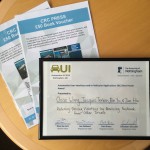Kai Kang, Bart Hengeveld, Caroline Hummels, Jun Hu
Positive peer interaction in nursing homes has been consistently recognized as essential to residents’ life quality. However, low rates of resident-to-resident interaction were found to be pervasive. Our research explores the potential of applying public display systems to promote residents’ unplanned co-located interaction. This article describes the design and assessment of “Reading-to-Sharing” (R2S): a tabletop display system intended to improve nursing home residents’ social interaction by enhancing their public reading experience. R2S was assessed via supervised field trials, in which the participants were invited to experience R2S in real-life settings with necessary assistance. The objectives were mainly to investigate the participants’ engagement with R2S, user experience and the potential impact on residents’ social behaviors and feelings. The result showed that R2S was capable of engaging the participants in content viewing and sharing. It was effective in catalyzing and facilitating their social interaction. The participants’ perceived user experience was primarily favorable. Although R2S was anticipated to increase the participants’ mutual closeness, no statistically significant change was seen. The key implications were highlighted to guide the design of public display systems in this context.
FULLTEXT: PDF REFERENCE: BibTeX EndNote
DOI: 10.1080/10447318.2021.2016234







